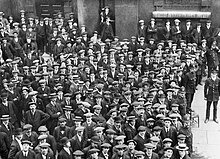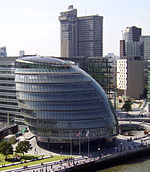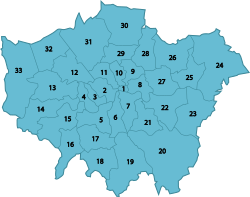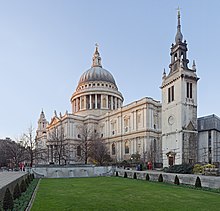Toponymy
The name London may derive from theRiver Thames
The etymology of London is uncertain. It is an ancient name and can be found in sources from the 2nd century. It is recorded c. 121 as Londinium, which points to Romano-British origin. The earliest attempted explanation, now disregarded, is attributed to Geoffrey of Monmouth in Historia Regum Britanniae. This had it that the name originated from a supposed King Lud, who had allegedly taken over the city and named it Kaerlud. From 1898 it was commonly accepted that the name was of Celtic origin and meant place belonging to a man called *Londinos; this explanation has since been rejected. Richard Coates put forward an explanation in 1998 that it is derived from the pre-Celtic Old European *(p)lowonida, meaning 'river too wide to ford', and suggested that this was a name given to the part of the River Thames which flows through London; from this, the settlement gained the Celtic form of its name, *Lowonidonjon; this requires quite a serious amendment however. The ultimate difficulty lies in reconciling the Latin formLondinium with the modern Welsh Llundain, which should demand a form *(h)lōndinion (as opposed to *londīnion), from earlier *loundiniom; however this has proved difficult to interpret. The possibility cannot be ruled out that the Welsh name was borrowed back in from English at a later date, and thus cannot be used as a basis from which to reconstruct the original name. Until 1889 the name "London" officially only applied to the City of London but since then it has also referred to the County of London and now Greater London.
Early modern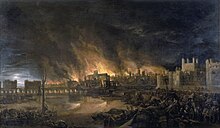
The Great Fire of London destroyed many parts of the city in 1666.
During the Tudor period the Reformation produced a gradual shift to Protestantism, with much of London passing from church to private ownership. The traffic in woollen cloths shipped undyed and undressed from London to the nearby shores of the Low Countries, for use by well-to-do wearers chiefly in the interior of the continent. But the tentacles of English maritime enterprise hardly extended beyond the seas of north-west Europe. The commercial route to Italy and the Mediterranean Sea normally lay through Antwerp and over the Alps; any ship passing through the Strait of Gibraltar to or from England were likely to be Italian or Ragusan. Upon the re-opening of the Netherlands to English shipping in January 1565 there at once ensued a strong outburst of commercial activity. The Royal Exchange was founded. Mercantilism grew and monopoly trading companies such as the East India Company were established, with trade expanding to the New World. London became the principal North Sea port, with migrants arriving from England and abroad. The population rose from an estimated 50,000 in 1530 to about 225,000 in 1605. In the 16th century William Shakespeare and his contemporaries lived in London at a time of hostility to the development of the theatre. By the end of the Tudor period in 1603, London was still very compact. There was an assassination attempt on James I in Westminster, through the Gunpowder Ploton 5 November 1605. London was plagued by disease in the early 17th century, culminating in the Great Plague of 1665–1666, which killed up to 100,000 people, or a fifth of the population. The Great Fire of London broke out in 1666 in Pudding Lane in the city and quickly swept through the wooden buildings. Rebuilding took over ten years and was supervised by Robert Hooke as Surveyor of London. In 1708 Christopher Wren's masterpiece, St Paul's Cathedral was completed. During the Georgian era new districts such as Mayfair were formed in the west; and new bridges over the Thames encouraged development in South London. In the east, the Port of London expanded downstream. In 1762 George III acquired Buckingham House and it was enlarged over the next 75 years. During the 18th century, London was dogged by crime and the Bow Street Runners were established in 1750 as a professional police force. In total, more than 200 offences were punishable by death, and women and children were hanged for petty theft. Over 74 per cent of children born in London died before they were five. The coffeehouse became a popular place to debate ideas, with growing literacy and the development of the printing press making news widely available; and Fleet Street became the centre of the British press. According to Samuel Johnson:
Architecture
30 St Mary Axe, also known as the Gherkin, towers over St Andrew Undershaft
London's buildings are too diverse to be characterised by any particular architectural style, partly due to their varying ages. Many grand houses and public buildings, such as the National Gallery, are constructed from Portland stone. Some areas of the city, particularly those just west of the centre, are characterised by white stucco or whitewashed buildings. Few structures in central London pre-date the Great Fire of 1666, these being a few trace Roman remains, the Tower of London and a few scattered Tudor survivors in the City. Further out is, for example, the Tudor periodHampton Court Palace, England's oldest surviving Tudor palace, built by Cardinal Thomas Wolsey c. 1515.Wren's late 17th century churches and the financial institutions of the 18th and 19th centuries such as the Royal Exchange and the Bank of England, to the early 20th century Old Bailey and the 1960s Barbican Estate form part of the varied architectural heritage. The disused, but soon to be rejuvenated, 1939 Battersea Power Station by the river in the southwest is a local landmark, while some railway termini are excellent examples of Victorian architecture, most notably St. Pancras andPaddington. The density of London varies, with high employment density in the central area, high residential densities in inner London and lower densities in Outer London. The Monument in the City of London provides views of the surrounding area while commemorating the Great Fire of London, which originated nearby. Marble Archand Wellington Arch, at the north and south ends of Park Lane respectively, have royal connections, as do the Albert Memorial and Royal Albert Hall inKensington. Nelson's Column is a nationally recognised monument in Trafalgar Square, one of the focal points of the city centre. Older buildings are mainly brick built, most commonly the yellow London stock brick or a warm orange-red variety, often decorated with carvings and white plaster mouldings. 
Buckingham Palace is the official residence of the British monarch
In the dense areas, most of the concentration is achieved with medium- and high-rise buildings. London's skyscrapers such as 30 St Mary Axe, Tower 42, the Broadgate Tower and One Canada Square are usually found in the two financial districts, the City of London and Canary Wharf. High-rise development is restricted at certain sites if it would obstruct protected views of St Paul's Cathedral and other historic buildings. Nevertheless there are a number of very tall skyscrapers to be found in central London (see Tall buildings in London), including the 72-storey Shard London Bridge, the tallest building in Europe. Other notable modern buildings include City Hall in Southwark with its distinctive oval shape, and the British Library in Somers Town/Kings Cross. What was formerly the Millennium Dome, located by the Thames to the east of Canary Wharf, is now used as an entertainment venue called The O2 Arena.
|
Prehistory and antiquity
In 1300 the City was still confined within the Roman walls.
Although there is evidence of scattered Brythonic settlements in the area, the first major settlement was founded by the Romans in 43 AD.This lasted for just seventeen years and around 61, the Iceni tribe led by Queen Boudica stormed it, burning it to the ground. The next, heavily planned incarnation of the city prospered and superseded Colchester as the capital of the Roman province of Britannia in 100. At its height during the 2nd century, Roman London had a population of around 60,000. By the 7th century, the Anglo-Saxons had created a new settlement called Lundenwic over a mile (2 km) upstream from the old Roman city, around what is now Covent Garden. It is likely that there was a harbour at the mouth of the River Fleet for fishing and trading, and this trading grew, until the city was overcome by theVikings and forced to move east, back to the location of the Roman Londinium, in order to use its walls for protection. Viking attacks continued to increase, until 886 when Alfred the Great recaptured London and made peace with the Danish leader, Guthrum. The original Saxon city of Lundenwic became Ealdwic ("old city"), a name surviving to the present day as Aldwych, which is in the modern City of Westminster. Two recent discoveries indicate that London could be much older than previously thought. In 1999 the remains of a Bronze Age bridge were found on the foreshore north of Vauxhall Bridge. This bridge either crossed the Thames, or went to a (lost) island in the river. Dendrology dated the timbers to 1500BC. In 2010 the foundations of a large timber structure, dated to 4500BC, were found on the Thames foreshore, South of Vauxhall Bridge. The function of the mesolithic structure is not known, but it covers at least 50m x 10m, and numerous 30 cm posts are visible at low tides. Both structures are on South Bank, at a natural crossing point where the River Effra flows into the River Thames, and 4 km upstream from the Roman City of London. The effort required to construct these structures implies trade, stability, and a community size of several hundred people at least.
Late modern and contemporary
A bombed out London street during the Blitz of World War II
London was the world's largest city from about 1831 to 1925. London's overcrowded conditions led to cholera epidemics, claiming 14,000 lives in 1848, and 6,000 in 1866. Rising traffic congestion led to the creation of the world's first local urban rail network. The Metropolitan Board of Worksoversaw infrastructure expansion in the capital and some of the surrounding counties; it was abolished in 1889 when the London County Council was created out of those areas of the counties surrounding the capital . The Blitz and other bombing by the German Luftwaffe during World War II killed over 30,000 Londoners and destroyed large tracts of housing and other buildings across London. Immediately after the war, the 1948 Summer Olympics were held at the original Wembley Stadium, at a time when the city had barely recovered from the war. In 1951 the Festival of Britain was held on the South Bank. The Great Smog of 1952 led to the Clean Air Act 1956, which ended the "pea-souper" fogs for which London had been notorious. From the 1940s onwards, London became home to a large number of immigrants, largely from Commonwealthcountries such as Jamaica, India, Bangladesh and Pakistan, making London one of the most diverse cities in Europe. Primarily starting in the mid-1960s, London became a centre for the worldwide youth culture, exemplified by the Swinging London subculture associated with the King's Road, Chelsea and Carnaby Street. The role of trendsetter was revived during the punk era. In 1965 London's political boundaries were expanded to take into account the growth of the urban area and a new Greater London Council was created. During The Troubles in Northern Ireland, London was subjected to bombing attacks by the Provisional IRA. Racial inequality was highlighted by the 1981 Brixton riot. Greater London's population declined steadily in the decades after World War II, from an estimated peak of 8.6 million in 1939 to around 6.8 million in the 1980s. The principal ports for London moved downstream to Felixstowe and Tilbury, with the London Docklands area becoming a focus for regeneration as theCanary Wharf development. This was borne out of London's ever-increasing role as a major international financial centre during the 1980s. The Thames Barrier was completed in the 1980s to protect London against tidal surges from the North Sea. The Greater London Council was abolished in 1986, which left London as the only large metropolis in the world without a central administration. In 2000, London-wide government was restored, with the creation of the Greater London Authority. To celebrate the start of the 21st century, the Millennium Dome, London Eye and Millennium Bridge were constructed. On 6 July 2005 London was awarded the 2012 Summer Olympics, making London the first city to stage the Olympic Games three times.
Parks and gardens
Aerial view of Hyde Park
The largest parks in the central area of London are three of the Royal Parks, namely Hyde Park and its neighbour Kensington Gardens at the western edge of central London, and Regent's Park on the northern edge. Regent's Park contains London Zoo, the world's oldest scientific zoo, and is located near the tourist attraction of Madame Tussauds Wax Museum. Closer to central London are the smaller Royal Parks of Green Park and St. James's Park. Hyde Park in particular is popular for sports and sometimes hosts open-air concerts. A number of large parks lie outside the city centre, including the remaining Royal Parks of Greenwich Park to the south-east and Bushy Park and Richmond Park (the largest) to the south-west, as well as Victoria Park, London to the east. Primrose Hillto the north of Regent's Park is a popular spot to view the city skyline. Some more informal, semi-natural open spaces also exist, including the 320-hectare (790-acre) Hampstead Heath of North London. This incorporates Kenwood House, the former stately home and a popular location in the summer months where classical musical concerts are held by the lake, attracting thousands of people every weekend to enjoy the music, scenery and fireworks.
Buses and trams
The red double-decker bus is an iconic symbol of London
London's bus network is one of the largest in the world, running 24 hours a day, with 8,000 buses, 700 bus routes, and over 6 million passenger journeys made every weekday. In 2003, the network had an estimated 1.5 billion commuter trips per annum, more than the Underground. Around £850 million is taken in revenue each year. London has the largest wheelchair accessible network in the world and, from the 3rd quarter of 2007, became more accessible to hearing and visually impaired passengers as audio-visual announcements were introduced. The distinctive red double-decker buses are internationally recognised, and are a trademark of London transport along with black cabs and the Tube. London has a modern tram network, known as Tramlink, based in Croydon in South London. The network has 39 stops, three routes and carried 26.5 million people in 2008. Since June 2008 Transport for London has completely owned Tramlink and plans to spend £54m by 2015 on maintenance, renewals, upgrades and capacity enhancements. Since April 2009 all trams have been refurbished.
|
Middle Ages
The Lancastrian siege of London in 1471 is attacked by aYorkist sally.
With the collapse of Roman rule in the early 5th century, London was effectively abandoned. However, from the 6th century an Anglo-Saxon settlement known asLundenwic developed slightly to the west of the old Roman city, around what is now Covent Garden and the Strand, rising to a likely population of 10–12,000.In the 9th century London was repeatedly attacked by Vikings, leading to a relocation of the city back to the location of Roman Londinium, in order to use its walls for protection. Following the unification of England in the 10th century London, already the country's largest city and most important trading centre, became increasingly important as a political centre, although it still faced competition from Winchester, the traditional centre of the kingdom of Wessex. In the 11th century King Edward the Confessor re-founded and rebuilt Westminster Abbey and Westminster, a short distance upstream from London became a favoured royal residence. From this point onward Westminster steadily supplanted the City of London itself as a venue for the business of national government. 
Westminster Abbey is a World Heritage Site and one of London's oldest and most important buildings as seen in this painting (Canaletto, 1749)
Following his victory in the Battle of Hastings, William, Duke of Normandy, was crowned King of England in the newly finished Westminster Abbey on Christmas Day 1066. William constructed the Tower of London, the first of the many Norman castles in England to be rebuilt in stone, in the southeastern corner of the city to intimidate the native inhabitants. In 1097, William II began the building of Westminster Hall, close by the abbey of the same name. The hall became the basis of a new Palace of Westminster. During the 12th century the institutions of central government, which had hitherto accompanied the royal court as it moved around the country, grew in size and sophistication and became increasingly fixed in one place. In most cases this was Westminster, although the royal treasury, having been moved from Winchester, came to rest in the Tower. While the City of Westminster developed into a true capital in governmental terms, its distinct neighbour, the City of London, remained England's largest city and principal commercial centre and flourished under its own unique administration, the Corporation of London. In 1100 its population was around 18,000; by 1300 it had grown to nearly 100,000. Disaster struck during the Black Death in the mid-14th century, when London lost nearly a third of its population. London was the focus of thePeasants' Revolt in 1381.
Government
Local governmentMain articles: Local government in London, History of local government in London, and List of heads of London government
The administration of London is formed of two tiers—a city-wide, strategic tier and a local tier. City-wide administration is coordinated by the Greater London Authority (GLA), while local administration is carried out by 33 smaller authorities. The GLA consists of two elected components; the Mayor of London, who has executive powers, and the London Assembly, who scrutinise the mayor's decisions and can accept or reject his budget proposals each year. The headquarters of the GLA is City Hall, Southwark; the current mayor is Boris Johnson. The mayor's statutory planning strategy is published as the London Plan, which was most recently revised in 2011. The local authorities are the councils of the 32 London boroughs and the City of London Corporation.They are responsible for most local services, such as local planning, schools, social services, local roads and refuse collection. Certain functions, such aswaste management, are provided through joint arrangements. In 2009–2010 the combined revenue expenditure by London councils and the GLA amounted to just over 22 billion ₤ (14.7 billion ₤ for the boroughs and 7.4 billion ₤ for the GLA) Policing in Greater London, with the exception of the City of London, is provided by the Metropolitan Police Force, overseen by the Metropolitan Police Authority. The City of London has its own police force – the City of London Police. The British Transport Police are responsible for police services onNational Rail and London Underground services. The London Fire Brigade is the statutory fire and rescue service for Greater London. It is run by the London Fire and Emergency Planning Authority and is the third-largest fire service in the world. National Health Service ambulance services are provided by the London Ambulance Service (LAS) NHS Trust, the largest free at the point of use emergency ambulance service in the world. The London Air Ambulance charity operates in conjunction with the LAS where required. Her Majesty's Coastguard and the Royal National Lifeboat Institution operate on the River Thames. National governmentLondon is the seat of the Government of the United Kingdom, which is located around the Palace of Westminster. Many government departments are located close to Parliament, particularly along Whitehall, including the Prime Minister's residence at 10 Downing Street. The British Parliament is often referred to as the "Mother of Parliaments" (although this sobriquet was first applied to England itself by John Bright) because it has been the model for most other parliamentary systems, and its Acts have created many other parliaments.
DistrictsLondon's vast urban area is often described using a set of district names, such asBloomsbury, Mayfair, Wembley and Whitechapel. These are either informal designations, reflect the names of villages that have been absorbed by sprawl, or are superseded administrative units such as parishes or former boroughs. Such names have remained in use through tradition, each referring to a local area with its own distinctive character, but without current official boundaries. Since 1965 Greater London has been divided into 32 London boroughs in addition to the ancient City of London. The City of London is the main financial district and Canary Wharfhas recently developed into a new financial and commercial hub, in the Docklands to the east. The West End is London's main entertainment and shopping district, attracting tourists. West London includes expensive residential areas where properties can sell for tens of millions of pounds. The average price for properties in Kensington and Chelsea is £894,000 with similar average outlay in most of central London. The East End is the area closest to the original Port of London, known for its high immigrant population, as well as for being one of the poorest areas in London. The surrounding East London area saw much of London's early industrial development; now, brownfield sites throughout the area are being redeveloped as part of the Thames Gateway including theLondon Riverside and Lower Lea Valley, which is being developed into the Olympic Park for the 2012 Olympics and Paralympics.
Demography
With increasing industrialisation, London's population grew rapidly throughout the 19th and early 20th centuries, and it was for some time in the late 19th and early 20th centuries the most populous city in the world until overtaken by New York in 1925. Its population peaked at 8,615,245 in 1939 immediately before the outbreak of the Second World War. There were an estimated 7,556,900 official residents in Greater London as of mid-2007. However, London's continuous urban area extends beyond the borders of Greater London and was home to 8,278,251 people in 2001, while its widermetropolitan area has a population of between 12 and 14 million depending on the definition used. According to Eurostat, London is the most populous city and metropolitan area of the European Union and the second most populous in Europe (or third if Istanbul is included). During the period 1991–2001 a net 726,000 immigrants arrived in London. The region covers an area of 1,579 square kilometres (610 sq mi). The population density is 4,542 inhabitants per square kilometre (11,760 /sq mi), more than ten times that of any other British region. In terms of population, London is the 25th largest city and the 18th largest metropolitan region in the world. It is also ranked 4th in the world in number of billionaires (United States Dollars) residing in the city. London ranks as one of the most expensive cities in the world, alongside Tokyo and Moscow.
ReligionThe majority of Londoners – 58.2 per cent – identify themselves as Christians. This is followed by those of no religion (15.8 per cent), Muslims (8.5 per cent), Hindus (4.1 per cent), Jews (2.1 per cent), Sikhs (1.5 per cent), Buddhists (0.8 per cent) and other (0.2 per cent), though 8.7 per cent of people did not answer this question in the 2001 Census. London has traditionally been Christian, and has a large number of churches, particularly in the City of London. The well-known St Paul's Cathedral in the City and Southwark Cathedral south of the river are Anglican administrative centres, while the Archbishop of Canterbury, principal bishop of the Church of England and worldwide Anglican Communion, has his main residence at Lambeth Palace in the London Borough of Lambeth. Important national and royal ceremonies are shared between St Paul's and Westminster Abbey. The Abbey is not to be confused with nearby Westminster Cathedral, which is the largest Roman Catholic cathedral in England and Wales. Despite the prevalence of Anglican churches, observance is very low within the Anglican denomination. Church attendance continues on a long, slow, steady decline, according to Church of England statistics. London is also home to sizeable Muslim, Hindu, Sikh, and Jewish communities. Many Muslims live in Tower Hamlets and Newham; the most important Muslim edifice is London Central Mosque on the edge of Regent's Park. Following the oil boom, increasing numbers of wealthy Middle-Eastern Muslims have based themselves around Mayfair andKnightsbridge in west London. London is home to the largest mosque in western Europe, the Baitul Futuh Mosque, of the Ahmadiyya Muslim Community. London's large Hindu community is found in the north-western boroughs of Harrow and Brent, the latter of which is home to one of Europe's largest Hindu temples, Neasden Temple. London is also home to 42 Hindu temples. Sikh communities are located in East and West London, which is also home to the largest Sikh temple in the world outside India. The majority of British Jews live in London, with significant Jewish communities in Stamford Hill, Stanmore, Golders Green, Hampstead, Hendon andEdgware in North London. Stanmore and Canons Park Synagogue has the largest membership of any single Orthodox synagogue in the whole of Europe, overtaking Ilford synagogue (also in London) in 1998. The community set up the London Jewish Forum in 2006 in response to the growing significance of devolved London Government.
|
|||||||||||||||||||||||||||||||||||||||||||||||||||||||||||||||||||||
|
|
|
|



